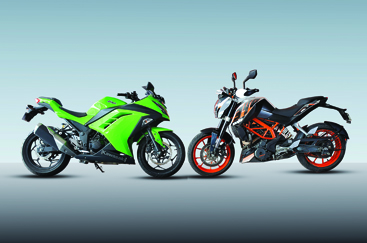In the last year, motorcycle enthusiasts across India have been spoilt for choice, especially when it comes to deciding on affordable, yet sporty motorcycles. Much of this is thanks to Pune-based Bajaj Auto, a company that has brought Indians two high performance motorcycles, the KTM 390 Duke and Kawasaki Ninja 300. This duo is among the best lightweight sportsbikes money can buy today, bringing to the table a heady mix of up-to-date style, top-notch specifications and really strong performance for the class.
The 390 Duke and Ninja 300 fit their parts as modern day sportsbikes viewed from any angle. However, their basic philosophies are more akin to chalk and cheese. The butch 390 is a naked sporty streetbike, where the mean 300 is a sleeker, fully-faired and unabashedly track-focussed motorcycle.
In terms of engines, the 390 Duke and Ninja 300 once again stand poles apart. The KTM uses a 373.3cc, single-cylinder engine, while the Ninja 300 houses a 296cc, parallel-twin. Both motorcycles run liquid-cooled, with fuel-injection offered as standard. The KTM is the more powerful motorcycle, generating 43.5bhp at 9000rpm, while peak torque is 3.57kgm at 7000rpm. The Kawasaki engine revs higher, as is more fitting, and produces maximum power of 38.5bhp at 11000 rpm, with 2.8kgm of torque on supply at 10000rpm. Both engines are built to perform.

